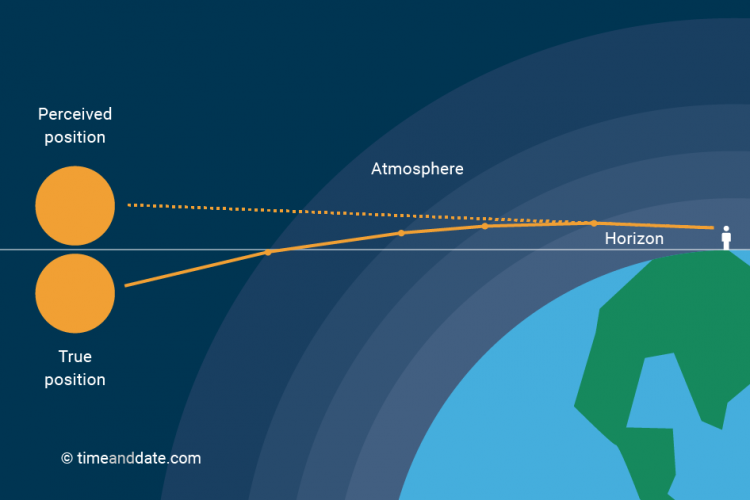Wed., March 20, 2019
Is the Equinox equal?
The Spring (or vernal) Equinox arrives this evening as the sun will be directly above the Equator at 5:58 EDT. And, even though the word equinox roughly translates into “equal night”, that’s not exactly true. The common interpretation for the day of the equinox is 12 hours of day and 12 hours of night. But if you look at the sunrise/sunset table, you’ll see today has 12 hours 8 minutes between sunrise and sunset. So, day and night are not 12-12 as most people think.
What accounts for the extra 8 minutes? Our atmosphere! On its roughly 93 million mile journey to Earth, sunlight travels through a vacuum. For the last 10-20 miles, however, the sunlight encounters a higher density medium (the atmosphere). The closer it comes to the surface, the higher the density. When light travels into a region of higher density, it bends. This bending is properly called refraction. Or, in the case of the sunlight and Earth, atmospheric refraction.
Courtesy: timeanddate.com
So, when we see the sun sitting on the horizon, it is actually below the horizon. But, we still “see” the sun because the atmosphere refracts (bends) the sunlight back to our eyes. From the time we perceive the sun on the horizon until it drops out of our vision, four minutes go by.
So, if the Earth had no atmosphere (we’d be in BIG trouble), sun rise and set would be exactly 12 hours apart. Because we do have an atmosphere, you must add the extra 4 minutes at sunrise and four more at sunset. Thus, the day of the Equinox has 12 hours 8 minutes between sunrise and sunset
Full moon tonight
The March full moon is most commonly called the Worm Moon (think robins in the early spring). It has many lessor known names as well…Lenten Moon, Crow Moon, Crust Moon, Chaste Moon, Sugar Moon and Sap Moon.
Our moon will be “full” at 9:42 P.M. Moon rise tonight at 7:38 PM EDT.
Wait, one more thing…
Just trying to wrap things up in a neat little package…
Q. Why does the moon look much larger near the horizon than it does higher in the sky?
Ans: atmospheric refraction (plus something called the apparent shape of the sky) Note: The moon on the horizon problem is still considered as the Moon Illusion. People have been trying to explain it for over 2000 years. Ptolemy was one the first to try. His suggestion was very similar to the one I gave above. But, it’s still under debate.

